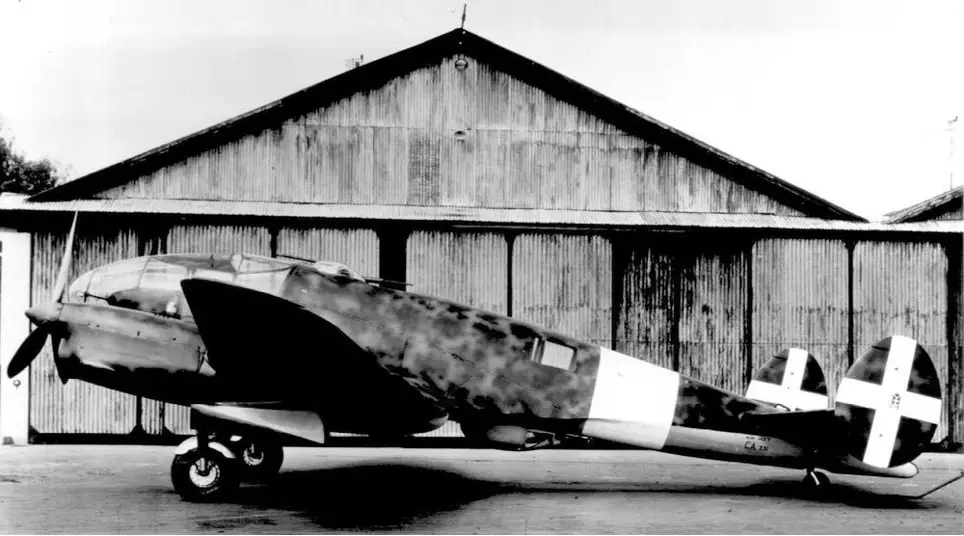Design
The history of the CA 331 can be taken as an example of a very long development path, in which the potential of a very interesting aircraft is limited by poor decision-making and economic limitations.
The CA 331 was designed as a long-range reconnaissance twin-engine bomber, following a long-standing tradition of the Caproni factory with this type of aircraft. It flew for the first time on August 31st, 1940, piloted by Ettore Wengi. The aircraft had a crew of three and its propulsion relied on two Isotta-Fraschini “delta” ARC 40 engines, developing 770 horsepower at 4000 m. The glass nose and cockpit ensured a great degree of visibility for the pilot and the observer. Behind the pilot seat, there was a small space for the radio operator, who could also man a 12,7mm machine gun in a dorsal turret. The armament is completed with two 12.7 machine guns on the wings, and the possibility of carrying 1000 kg of bombs in an internal hold.
History
The aircraft is ordered by the Italian Air Force (Regia Aeronautica) in three prototypes. The early test flights immediately earned promising results. Despite the low installed power, the plane was able to reach 480 km/h at 5100 meters, mainly thanks to the excellent aerodynamics of the fuselage. The CA 331 was in fact a very innovative design (for Italian standards) and the first entirely metal creation of the CAPRONI BERGAMASCHE company. The fuselage structure also had a hard aluminium coating.
Technical assessments took place according to the usual routine: flight tests in Guidonia (near Rome) in the spring of 1941 and firing tests in the summer of the same year. Although the test results are good, the Air force does not show any further interest, not even for a small order of aircraft of the first model (the” 0” series).
Consequently, the CA 331 returns to the Caproni factory, where it will be examined by a German delegation in late 1941. The new tests conducted by the Germans earned favourable impressions. The Luftwaffe then asks to send the prototype to an experimentation site in Rechlin (Germany) to conduct further tests.
In the summer of 1942, a CA331 and a CA 313 reach Reichlin. The Luftwaffe is well impressed and places an order of 1000 CA 313 (G version for pilot training). The CA 331 was discarded due to the widespread use of light metal alloys, which were becoming increasingly scarce by mid-1942. In the meantime, the Regia Aeronautica ordered a new version of the aircraft, to be used as a heavy-night fighter.

In fact, in 1942 the air defence of Italian mainland became a pressing issue. The new requirements for the CA 331 (331b) led to the redesign of the nose, passing from glazed to solid and with the installation of 4 fixed arms of 12.7. In the autumn of 1942, there were further tests, earning satisfactory results and the Regia Aeronautica ordered the huge (although unrealistic) number of 1000 CA 331. The production was structured on different plants, building different components, with subsequent component assembly operations.
Such organization created major organizational problems and delays. This meant that by the date of the armistice, not even the first aircraft had left the assembly lines. The CA 331 in its latest configuration would have benefitted from various improvements, such as more powerful engines (825 hp) and newly designed propellers.
The armament also had improved, going from 4 MMG from 12.7 to 4x20mm guns. On another prototype, the installation of a ventral cradle with 6×20 mm guns was under development. These two CA331Bs were captured by the Germans and dismantled in September 1943 to recover valuable materials and
components. An anti-tank version with a 37 mm gun was also being studied. The short-lived story of a promising aircraft, came to halt mainly to the shortcomings and limits of the Italian industrial apparatus.
| Model | Caproni CA.331 |
| Crew | 3 |
| Powerplant | (2) Isotta Fraschini 825 HP Each |
| Maximum Speed | 505 km/h |
| Max Ceiling | 8,100 m |
| Range | 1815 km |
| Length | 11,74 m |
| Height | 3.48 m |
| Weight | Empty: 4,600 kg Max: 6,800 kg |
| Wing Area | 38.4 m2 |
| Wingspan | 16,4 m |
| Armament | (4) 12.7 mm Breda SAFAT machine guns |
Sources
Dimensione cielo, caccia assalto n.2. (1971). Roma: Edizioni Bizzarri.